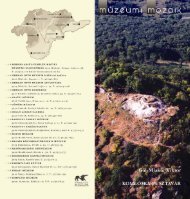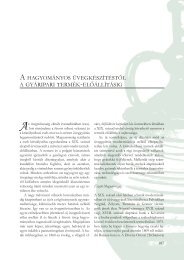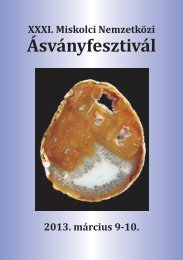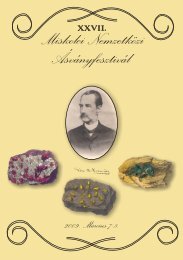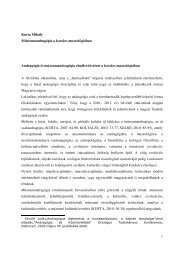Acta Mineralogica-Petrographica, Abstract Series 5, Szeged, 2006METASOMATIC-HYDRO<strong>THE</strong>RMAL PROCESSES ALONG <strong>THE</strong> CONTACT ZONE OFLOWER CRETACEOUS MAGMATIC SILLS <strong>IN</strong>TRUDED <strong>IN</strong>TO LOWER JURASSIC COALBEDS AT PÉCS-VASAS, MECSEK MTS., HUNGARYJÁGER, V.Department of Mineralogy, Herman Ottó Museum, Kossuth u. 13, H-3525 Miskolc, HungaryE-mail: jagerviktor@yahoo.co.ukIn the Mecsek Mts. Lower Cretaceous magmatic rock ofankaramite-alkali basalt series intruded in Lower Jurassicparalic coal seams. The coking effects and the fissure networksproduced by these magmatics in the coal deposits andtheir influence on hydrocarbon migration and methane explosionsin the coal mines has already been discussed in severalpapers, but the hydrothermal events caused by these magmaticsills have been barely mentioned yet.The magmatic sills generally intruded into the coal beds,on the whole concordantly with the coal seams.A few of the magmatic sills reach 6-7 meter in thickness.The sills bear conspicuous macroscopic features, i.e. a networkof cooling cracks parallel to the contacts with the coalbeds; another network of shorter cracks, perpendicularly tothe previous crack system; and directly along the contact acoke zone (up to 1.5 m in thickness) dissected by hexagonal,columnar joints. The change of colour of the sill from darkgreen through paler tints to whitish and the decrease of sizeand quantity of the phenocrysts from the centre of the silltowards the contacts are also obvious. The magmatic sillsfrequently contain cavities within 30-cm distance from thecontact; they are often flattened according to the flow direction.Some cavities reach 4-5 cm in diameter. They may containpyrite, siderite, calcite, quartz, barite and dickite. Thelargest quartz crystals in the cavities reach 2.5 cm. The cracknetwork of the sills is filled with minerals. These veinletsconsist of calcite, quartz, chalcedony, barite, pyrite, andrarely sphalerite crystals up to a few mm in size.Free-standing calcite, quartz and barite crystals in theveins may reach about 1 cm. It is conspicuous, that the quartzveinlets occur in the sill only within 0.7–1.5-m distance fromthe contact, depending on the thickness of the sill (within0.7 m for a 4-meter thick sill and within 1.5 m for a 6.5-meterthick one). In some sills brecciated claystone and coal xenolithshave been observed; in their surroundings there arecalcite veins containing euhedral quartz crystals of 1-2 cmlength. It is to be noted that on some places euhedral quartzor smoky quartz crystals of about 1-cm length can be foundin the fissures of the country rocks (siltstone and sandstone)within 1-2 m distance from the contact.The origin of hydrothermal minerals found in a 4-meterwide sill that intruded in a coal bed was studied using opticalmicroscopy and SEM-EDS. In the sample, collected from theinterior of the sill 1.7 m from the lower contact, there areeuhedral, 1-2 mm long, sector zoned pyroxene showing violetpleochroism, with a Ti content increasing towards the edges.This pyroxene is rich in Ca and Fe, in some crystals theamount of Cr is also considerable. Moreover, chromian spinelinclusions up to 5 µm are common. Ni-Co-(Fe) sulfide inclusionsof a few µm in size have also been found. Ilmenite andrutil inclusions (50–80 µm) are also common. In many casespyroxene has been calcitized and argillized along the cracks.Fresh kaersutite phenocrysts also occur. Plagioclase shows alabradorite–bytownite composition. The amount of analcimein the rock is considerable. Opaque minerals are ilmenite,titanomagnetite, and pyrite. Some pyrite grains contain galena,barite and Fe-rich sphalerite inclusions up to a few µm.The texture of the rock is microholocrystalline.1.3 m from the contact only small parts of pyroxene arefresh; it is mainly altered to calcite, clay minerals and ironoxides. Calcite occurs in the matrix, analcime has not beenobserved. In the rock calcite veins are getting more and morefrequent.90 cm from the contact pyroxene is totally altered to calcite,opal, lussatite, chalcedony, quartz, clay minerals andpartly iron oxides. The outline of the pyroxene was preserved,forming a pseudomorphous texture. Calcite andquartz varieties formed due to the alteration of pyroxene fillin crevices and coalescent cavities. Veinlets consisting ofrhombohedral, free-grown calcite, chalcedony, free-grownquartz and barite are remarkable. The plagioclase is calcitizedmore strongly than in the middle of the vein.50 cm from the contact pyroxene is totally altered to calcite.At about 30 cm from the contact even the remains of alteredphenocrystals are barely visible. The rock consists ofcalcite, clay minerals, quartz, iron oxides and pyrite. Its textureis microcrystalline, due to the faster cooling. At 30 cmfrom the contact the mineral-filled cavities are getting moreand more frequently. Pyritization is also intensive.Directly at the contact the magmatic rock is altered toclay minerals and iron oxide. In calcite veinlets found in thealeurolite 2-m from the lower contact of the magmatic sillthere are euhedral quartz crystals, 0.5 cm in length.A rough scenario of mineral formation can be summarisedas follows. The intrusion of the magmatic sills suddenlyelevated the pressure of aqueous vapour in the country rock.Released volatiles penetrated into the magma (having originallya lower vapour pressure) and formed first gas bubbles,which later dissolved. Volatiles reacted with the mineralscrystallizing from the magma. At about 90 cm from the contactsilica was released from the altered pyroxene and precipitatedas quartz in cavities and veinlets in the sill. CO 2 derivedfrom the coal beds reacted with Ca released from the alteredpyroxene and plagioclase to form calcite. In the middle of thesill barite and sphalerite are found as microscopic inclusionsin pyrite, but in the veinlets near to the contact they alreadyreach some mm (sphalerite) or 1 cm in size (barite). This factsuggests Ba and Zn mobilization and migration from thecountry rock into the sill driven by the hydrothermal processes.50www.sci.u-szeged.hu/asvanytan/acta.htm
Acta Mineralogica-Petrographica, Abstract Series 5, Szeged, 2006MARMAROSH DIAMONDS – <strong>THE</strong> TYPICAL ASSOCIATION WITH <strong>THE</strong> ORGANICMATTER <strong>IN</strong> <strong>THE</strong> OUTER <strong>CARPATHIANS</strong>JARMOŁOWICZ-SZULC, K. 1 , KARWOWSKI, Ł. 2 & DUDOK, I. V. 31 Polish Geological Institute, Rakowiecka 4, 00-975 Warsaw, PolandE-mail: katarzyna.jarmolowicz-szulc@pgi.gov.pl2 Department of Geochemistry, Mineralogy and Petrology, University of Silesia, Będzińska 60, 41-200 Sosnowiec, Poland3 Institute of Geology and Geochemistry of Combustible Minerals, Academy of Sciences of Ukraine, Naukova 3a, 79053L’viv, UkraineThe Marmarosh diamonds (MD) – a special type of thequartz, locally called dragomites – occur in the Outer Carpathiansover a widespread area in a distinct paragenesis withdifferent hydrocarbonic compounds. Since their descriptionby TOKARSKI (1905), the MD have been a study object forabout a century aiming at explanation of the phenomena ofmineral formation and characteristics (e.g. VOZNYAK et al.,1973; KOZŁOWSKI et al., 1996). In Polish and Ukrainianterritories, the following areas have been defined as examplesof MD occurrence: the Mszana Dolna (Poland) tectonic window– KARWOWSKI & DORDA (1986); HURAI et al.(2002), the Rabe region (Bieszczady Mts., Poland) –JARMOŁOWICZ-SZULC & DUDOK (2005), the Stavnevillage vicinity (Ukraine) – DUDOK & JARMOŁOWICZ-SZULC (2000).Despite their above described occurrence, the MD have ingeneral a very characteristic euhedral crystal habit, transparencyand a perfect reflection (KARWOWSKI & DORDA,1986). There is a combination of rhombohedra (10 1 1) and(01 1 1), rare trigonal pyramid (11 2 1) and hexagonal prism(10 1 0). In the studied samples, that last one is often short ortotally reduced.The observed MD are present in the fissures, either ascrystals in quartz veins or in the Carpathian fractures filledadditionally with other minerals as calcite (at least two generations),traces of ore mineralization (e.g. pyrite) and theorganic matter. The presence of primary or of secondaryhydrocarbon inclusions is a characteristic phenomenon of theMD. Those primary ones observed in three sample areas, maybe divided into three phase groups of state, being of homogeneousor heterogeneous nature. The solid inclusions comprisedifferent bitumens, while the liquid inclusions are filled withdifferent non-mixing fluids. Gas inclusions contain methanewith some admixtures of heavier hydrocarbons, nitrogen andoccasionally carbon dioxide. The heterogenic inclusionscontain different types of the filling, e.g. gas and liquid hydrocarbonand the aqueous solution; gas and heavy hydrocarbonand the aqueous solution and solid bitumens etc. Heavybitumens are rare in quartz. When present, they are responsiblefor the black colour of the crystals. Such feature wasobserved in the Rabe region together with a relatively longcrystal form, i.e. with a well-developed hexagonal prism. TheMszana Dolna area is full of quartz crystallized directly onthe fissure walls, with calcite veinlets in the neighbourhood,tectonically disturbed. Such quartz is observed eastwards,too, in the tectonically engaged places. In other localities,individual crystals occur in “pockets” with black organicmatter. For the vein formations of the Eastern Carpathians,the presence of anthraxolite is shown (DUDOK et al., 2002).Based on the studies conducted pT conditions of the mineralformation may be stated as: high pressure values in theMszana region (0.75–2 kbar, compare: HURAI et al., 2002),lower in the Rabe vicinity (0.9–1.7 kbar, JARMOŁOWICZ-SZULC & DUDOK, 2005) and the highest near Stavne (2.4–2.7 kbar, DUDOK & JARMOŁOWICZ-SZULC, 2000).Temperatures fall into a wide interval, while local differencesenable a wide regional discussion of the formation history.ReferencesDUDOK, I. V. & JARMOŁOWICZ-SZULC, K. (2000):Geological Quarterly, 44: 415–423.DUDOK, I.V., KOTARBA, M. & JARMOŁOWICZ-SZULC, K. (2002): Geologiya i Geokhimiya GoryuchikhKopalin: 76-87.HURAI, V., KIHLE, J., KOTULOVA, J., MARKO, F. &ŚWIERCZEWSKA, A. (2002): Applied Geochemistry,17: 1259–1271.JARMOŁOWICZ -SZULC, K. & DUDOK, I. V. (2005):Geological Quarterly, 49: 291–304.KARWOWSKI, Ł. & DORDA, J. (1986): Mineralogia Polonica,17: 3–12.KOZŁOWSKI, A., METZ, P. & MŁYNARCZYK, M.(1996): Jahrestagung der Deutschen Mineralogischen Gesellschaft,Kiel, 9–12 September 1996. Berichte derDeutschen Mineralogischen Gesellschaft – Nachtrag vonKurzreferaten.TOKARSKI, J. (1905): Kosmos, 30: 443–460.VOZNYAK, D. K., GRYCIK, V.V., KVASNYTSYA, V. N.& GALABURDA, Y. A. (1973): Dopovidi AkademiiNauk URSR, 12: 1050–1062.www.sci.u-szeged.hu/asvanytan/acta.htm 51
- Page 1: MSCC33 rd MINERAL SCIENCES IN THE C
- Page 5 and 6: Acta Mineralogica-Petrographica, Ab
- Page 7 and 8: Acta Mineralogica-Petrographica, Ab
- Page 9 and 10: Acta Mineralogica-Petrographica, Ab
- Page 11 and 12: Acta Mineralogica-Petrographica, Ab
- Page 13 and 14: Acta Mineralogica-Petrographica, Ab
- Page 15 and 16: Acta Mineralogica-Petrographica, Ab
- Page 17 and 18: Acta Mineralogica-Petrographica, Ab
- Page 19 and 20: Acta Mineralogica-Petrographica, Ab
- Page 21 and 22: Acta Mineralogica-Petrographica, Ab
- Page 23 and 24: Acta Mineralogica-Petrographica, Ab
- Page 25 and 26: Acta Mineralogica-Petrographica, Ab
- Page 27 and 28: Acta Mineralogica-Petrographica, Ab
- Page 29 and 30: Acta Mineralogica-Petrographica, Ab
- Page 31 and 32: Acta Mineralogica-Petrographica, Ab
- Page 33 and 34: Acta Mineralogica-Petrographica, Ab
- Page 35 and 36: Acta Mineralogica-Petrographica, Ab
- Page 37 and 38: Acta Mineralogica-Petrographica, Ab
- Page 39 and 40: Acta Mineralogica-Petrographica, Ab
- Page 41 and 42: Acta Mineralogica-Petrographica, Ab
- Page 43 and 44: Acta Mineralogica-Petrographica, Ab
- Page 45 and 46: Acta Mineralogica-Petrographica, Ab
- Page 47 and 48: Acta Mineralogica-Petrographica, Ab
- Page 49: Acta Mineralogica-Petrographica, Ab
- Page 53 and 54: Acta Mineralogica-Petrographica, Ab
- Page 55 and 56: Acta Mineralogica-Petrographica, Ab
- Page 57 and 58: Acta Mineralogica-Petrographica, Ab
- Page 59 and 60: Acta Mineralogica-Petrographica, Ab
- Page 61 and 62: Acta Mineralogica-Petrographica, Ab
- Page 63 and 64: Acta Mineralogica-Petrographica, Ab
- Page 65 and 66: Acta Mineralogica-Petrographica, Ab
- Page 67 and 68: Acta Mineralogica-Petrographica, Ab
- Page 69 and 70: Acta Mineralogica-Petrographica, Ab
- Page 71 and 72: Acta Mineralogica-Petrographica, Ab
- Page 73 and 74: Acta Mineralogica-Petrographica, Ab
- Page 75 and 76: Acta Mineralogica-Petrographica, Ab
- Page 77 and 78: Acta Mineralogica-Petrographica, Ab
- Page 79 and 80: Acta Mineralogica-Petrographica, Ab
- Page 81 and 82: Acta Mineralogica-Petrographica, Ab
- Page 83 and 84: Acta Mineralogica-Petrographica, Ab
- Page 85 and 86: Acta Mineralogica-Petrographica, Ab
- Page 87 and 88: Acta Mineralogica-Petrographica, Ab
- Page 89 and 90: Acta Mineralogica-Petrographica, Ab
- Page 91 and 92: Acta Mineralogica-Petrographica, Ab
- Page 93 and 94: Acta Mineralogica-Petrographica, Ab
- Page 95 and 96: Acta Mineralogica-Petrographica, Ab
- Page 97 and 98: Acta Mineralogica-Petrographica, Ab
- Page 99 and 100: Acta Mineralogica-Petrographica, Ab
- Page 101 and 102:
Acta Mineralogica-Petrographica, Ab
- Page 103 and 104:
Acta Mineralogica-Petrographica, Ab
- Page 105 and 106:
Acta Mineralogica-Petrographica, Ab
- Page 107 and 108:
Acta Mineralogica-Petrographica, Ab
- Page 109 and 110:
Acta Mineralogica-Petrographica, Ab
- Page 111 and 112:
Acta Mineralogica-Petrographica, Ab
- Page 113 and 114:
Acta Mineralogica-Petrographica, Ab
- Page 115 and 116:
Acta Mineralogica-Petrographica, Ab
- Page 117 and 118:
Acta Mineralogica-Petrographica, Ab
- Page 119 and 120:
Acta Mineralogica-Petrographica, Ab
- Page 121 and 122:
Acta Mineralogica-Petrographica, Ab
- Page 123 and 124:
Acta Mineralogica-Petrographica, Ab
- Page 125 and 126:
Acta Mineralogica-Petrographica, Ab
- Page 127 and 128:
Acta Mineralogica-Petrographica, Ab
- Page 129 and 130:
Acta Mineralogica-Petrographica, Ab
- Page 131 and 132:
Acta Mineralogica-Petrographica, Ab
- Page 133 and 134:
Acta Mineralogica-Petrographica, Ab




